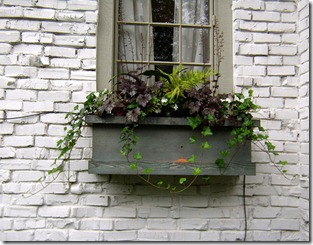 window boxes are highly versatile. You can use them for seasonal bedding with spring daffodils, summer annuals, and fall and winter evergreens. You can color- coordinate your schemes for hothouse reds or pale pastels or you can concentrate on scent. When planting, remember that the plants will be visible from both inside and outside the window. Window boxes are also good at giving part of the building’s exterior a quick make-over. Tumbling, trailing ivies come with all kinds of leafshape, from the bird’s foot to the curly-edged, to the diamond-, fan-, and heart-shaped. The key to success, as with all containers, is firm fixings and excellent drainage. Old tins, used as containers, need plenty of drainage holes, and all need crocks, or polystyrene chips placed at the bottom before the addition of soil.
window boxes are highly versatile. You can use them for seasonal bedding with spring daffodils, summer annuals, and fall and winter evergreens. You can color- coordinate your schemes for hothouse reds or pale pastels or you can concentrate on scent. When planting, remember that the plants will be visible from both inside and outside the window. Window boxes are also good at giving part of the building’s exterior a quick make-over. Tumbling, trailing ivies come with all kinds of leafshape, from the bird’s foot to the curly-edged, to the diamond-, fan-, and heart-shaped. The key to success, as with all containers, is firm fixings and excellent drainage. Old tins, used as containers, need plenty of drainage holes, and all need crocks, or polystyrene chips placed at the bottom before the addition of soil.
A SPRING TROUGH
RIGHT: a mix of primulas, cineraria, and anemones. You can replace the spring display with herbs in summer.
A TOUCH OF THE BLUES
LEFT: You can use almost anything as a container, like these tins with drainage holes drilled into the back.
ELEGANT EXTRAS
OPPOSITE: smart period buildings need smart troughs. This is richly planted with pelargoniums.
POWERFUL PETUNIAS
ABOVE: There is now a huge color range of petunias, and some are wonderfully vibrant. The dark reds and blues, and paper colors are the easiest to use. Keep deadbeading them all season for a continuous supply of flowers.
SUMMER EXCESS
RIGHT: With an informal window box, the fuller the planting the better. Here, pelargoniums, petunias, lobelia, and helichrysum have been packed tightly together for maximum effect. Make sure that window boxes are regularly watered, which is high temperatures can mean twice a day. Note how the dwarf conifer and hebe give a permanent evergreen structure.

Deprecated: strpos(): Passing null to parameter #1 ($haystack) of type string is deprecated in /home/agriviek8Qv/agriviet.net/public_html/wp-includes/comment-template.php on line 2522